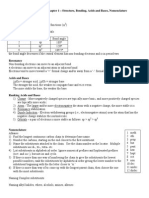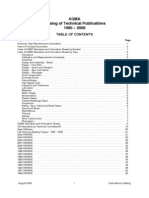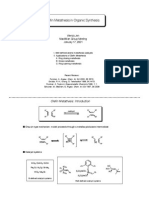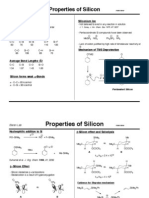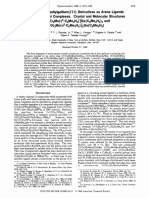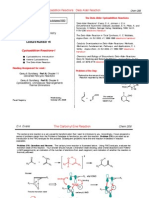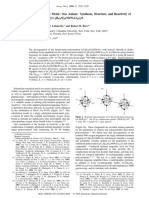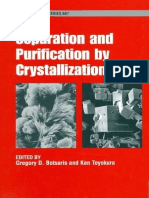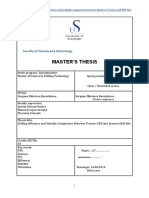Chen Feb 07
Chen Feb 07
Uploaded by
Debdeep RayCopyright:
Available Formats
Chen Feb 07
Chen Feb 07
Uploaded by
Debdeep RayOriginal Title
Copyright
Available Formats
Share this document
Did you find this document useful?
Is this content inappropriate?
Copyright:
Available Formats
Chen Feb 07
Chen Feb 07
Uploaded by
Debdeep RayCopyright:
Available Formats
Baran Group Meeting 1/31/2007
Fischer Carbene Complexes in Organic Synthesis
Ernst Otto Fischer (1918 - ) German inorganic chemist. Born in Munich on November 10, 1918. Studied at Munich Technical University and spent his career there. Became director of the inorganic chemistry institute in 1964. In the 1960s, discovered a metal alkylidene and alkylidyne complexes, referred to as Fischer carbenes and Fischer carbynes. Shared the Nobel Prize in Chemistry with Geoffery Wilkinson in 1973, for the pioneering work on the chemistry of organometallic compounds. Other Types of Stabilized Carbenes:
Ke Chen
Schrock carbene, named after Richard R. Schrock, is nucleophilic at the carbene carbon atom in an unpaired triplet state. Comparision of Fisher Carbene and Schrock carbene:
Schrock carbenes are found with: Isolation of first transition-metal carbene complex:
LiMe
(CO)5W CO (CO)5W O
E. O. Fischer, A. Maasbol, Angew. Chem. Int. Ed., 1964, 3, 580.
Representatives:
CH2 Cp2Ta CH3
Me
CH2N2
Me (CO)5W OMe
high oxidation states early transition metals Ti(IV), Ta(V) non pi-acceptor ligands non pi-donor substituents
A.B. Charette J. Am. Chem. Soc. 2001, 123, 11829.
Persistent carbenes, isolated as a crystalline solid by Anthony J. Arduengo in 1991, can exist in the singlet state or the triplet state.
Representative Fischer Carbenes:
W(CO)5 Me OMe Ph Cr(CO)5 Ph Ph Fe(CO)4 NEt2 Ph Mn(CO)2(MeCp) OTiCp2Cl Me Co(CO)3SnPh3 OMe
Fischer carbenes are found with : low oxidation state metals; middle and late transition metals Fe(0), Mo(0), Cr(0), W(0); pi-electron acceptor metal ligands; pi-donor substituents on methylene group such as alkoxy and amino groups.
Foiled carbenes were defined as "systems where stabilization is obtained by the inception of the facile reaction which is foiled by the impossibility of attaining the final product geometry". They only exist in the singlet state.
Rolf Gleiter, Ronald Hoffman J. Am. Chem. Soc. 1968, 90, 5457 - 5460. Jean-Luc Mieusset and Udo H. Brinker J. Am. Chem. Soc. 2006, 128, 15843 - 15850.
Baran Group Meeting 1/31/2007
Fischer Carbene Complexes in Organic Synthesis
Ke Chen
Advantages over regular carbenes - From fleeting intermediates to powerful reagents 1. Improved stability Typical carbenes such as diphenyl carbene have lifetimes in the nanosecond regime.
2. Excellent functional group compatibility - serving as blocking groups in organic synthesis.
OTMS OMe [Cr] Ph OMe Ph H O
BuLi, THF, -78 oC
Et
[Cr] Et
75 %
Most Fischer carbene complexes are stable to air and water and to dilute acids and bases. Despite the high dipole moment of these complexes (~ 4 - 5 Debye), most complexes can be purified by chromatography on silica gel with hexane as eluent and are usually the first compounds to elute. Identification of the fractions from the column containing the carbene complex can simply be done by eye on the basis of their color. The colors of complexes bearing alkoxy groups as the heteroatom-stabilizing group tend to correlate with the hybridzation of the carbon substituent of the carbene carbon. Those with sp3 carbons usually are yellow, those with sp2 carbons are normally red and those with sp hybridized carbon substituents are invariably an intense purple/black color.
3 equiv of CH2CHCH2Li, THF -78 oC to RT, then SiO2 71 %
[Cr]
Ph
Et
J. Barluenga. J. Am. Chem. Soc. 2002, 124, 9056 -9057.
3. Improved reactivity and selectivity
Cr(CO)5 MeO Cr(CO)5 Cr(CO)5 MeO
RT, 3 h 70 %
MeO
92
O MeO MeO O
:
O MeO
thermal conditions: RT, 7 months, 54 % AlCl3, 0.5 h , 50 %
http://www.chemistry.msu.edu/faculty/wulff/myweb26/research/carbenes.htm
70 95
: :
30 5
W. Wulff. J. Am. Chem. Soc. 1990, 112, 3642.
Baran Group Meeting 1/31/2007
Fischer Carbene Complexes in Organic Synthesis
Ke Chen
Synthesis of Fischer carbene complexes: 1. Standard Fischer route
M(CO)6 R1Li
OLi (OC)5M R1 HS R3 HN R4 SR3 (OC)5M R1 (OC)5M R1 NR3R4
2. Hegedus-Semmelhack approach
O
RX
OR2 (OC)5M R1 R3
M(CO)6
C8K
K2[M(CO)5]
O R1
R1
Cl
OK (OC)5M R1
R2X
OR2 (OC)5M R1
M = Cr, Mo, W R1 = alkyl, aryl, vinyl RX = R23O+BF4-, R2OSO3F R3, R4 = H, alkyl
NR3R4
O(OC)5M NR3R4 R1
TMSCl
NR3R4 (OC)5M R1
This is the most direct and general approach to Fischer carbene complexes; Limitations are the availability of organolithium compound and the alkylation reagent.
O OLi (OC)5M R1 R2 O X R2 (OC)5M R1 O
M = Cr, W R1 = alkyl, aryl, vinyl R2X = R23O+BF4-, R2OSO3F R3, R4 = H, alkyl
Me4N+Br-
O-NMe4+ (OC)5M R1
This strategy combining an organoelectrophile and a metal nucleophile can be extended to the synthesis of aminocarbene complexes.
M = Cr, W R1 = alkyl, aryl, vinyl R2 = Me, tBu X = Br, Cl R3 = terpene, sugar skeletons
(OC)5M
Recent reviews:
W. D. Wulff, in Comprehensive Organometallic Chemistry II, ed. A. W. Abel, F. G. A. Stone and G. Wilkinson, pergamon Press, Oxford, 1995, vol. 12, p. 469 L. S. Hegedus, ibid., vol. 12, p. 549.
R3OH
OR3 R1
This is the standard approach to optically active Fischer carbene complexes bearing alkoxy substituents.
Baran Group Meeting 1/31/2007
Fischer Carbene Complexes in Organic Synthesis
Ke Chen
Reaction pattern of carbene complexes: Part I: Ligand-centered
(OC)5M R OR (OC)5M R OR
Pattern B: Bond formation via metal carbene anions
OMe (OC)5Cr O OMe
C
OC CO OC Cr OC CO O R
pKa = 12
H3C N O N (OC)4Cr CH3 Ph CH3
pKa = 25
OH O N Ph O N CH3
E Nu
CR2 H
1. nBuLi 2. PhCHO 3. HOAc / Ce(IV) 60 %, > 96 % de
Ph
CH3
W. Wulff, J. Org. Chem., 1994, 6882.
Pattern A: Addition of nucleophiles
OMe (OC)5Cr Ph
OMe OMe - MeOH H (OC)5Cr NHR Ph O NHR Ph (OC)5Cr
1. nBuLi 2.
O
OMe (OC)5Cr OLi (OC)5Cr
NH2R
(OC)5Cr
OMe (OC)5Cr O Ph OLi Li
B. A. Anderson, J. Am. Chem. Soc., 1993, 115, 4602.
THF, -80 oC to RT Ph 50 %
O Cr(CO)5
Pattern C: Transformation of metal carbenes to metal carbynes
J. Barluengal, J. Chem. Soc., Chem. Commun. 1993, 1068
OMe (OC)5Cr Ph N
?
MeO
Ph N Cr(CO)5
H. Fischer, Chem. Ber. 1980, 113, 193 For reviews on reaction pattern of carbene complexes, see "Carbene Chemistry : From Fleeting Intermediates to Powerful Reagents", chapter 8.
Baran Group Meeting 1/31/2007
Fischer Carbene Complexes in Organic Synthesis
Diels-Alder reaction of boroxycarbene complexes:
Br CH3 N
Ke Chen
Reaction pattern of carbene complexes: Part I: Ligand-centered Cycloaddition reactions:
[2 + 2]
(OC)5W OMe OMe
OMe
1. t-BuLi, Et2O (OC)5Cr 2. Cr(CO)6, Et2O 3. BF3 Et2O, RT
.
F B N F
Ph
N Me
RT, 12 h 87 %
(OC)5W H3CO
CH3
K. L. Faron, J. Am. Chem. Soc. 1988, 110, 8727 -8729.
[3 + 2]
OMe (OC)5W
1.THF, -78 oC to RT 85% 2. 3N HCl, THF, RT 95 %
CHO N O (OC)5Cr O F B N O
J. Barluenga. J. Am. Chem. Soc. 1998, 120, 2514 -2522.
TMSCHN2 hexanes, RT 4.5 h, 87 %
OMe (OC)5W NH H3C N
HBr, DCM, RT 85 %
CH3
[4 + 2]
H 3C N O N (OC)4Cr Ph CH3 TBSO
W. D. Wulff, J. Am. Chem. Soc. 1986, 108, 5229 -5236.
H3C N O OCH3 N (OC)4Cr CH3O OTBS
W. D. Wulff, J. Am. Chem. Soc. 1997, 119, 6438 -6439.
CH3 Ph CH3
Miscellaneous cases
Ipc OLi (OC)5W Ph
(-) -Ipc2BCl, Et2O -78 oC to RT
Ph
DCM, RT, 12 h 80 %,single isomer
CH3
J. Barluenga, J. Am. Chem. Soc,, 1996, 118, 6090 -6091.
Intramolecular Pauson -Khand reaction:
NH (OC)5W
H2O2, NaOH 83 %, > 99 % de
OH OH
[Co2(CO)8] 75 %
Ph
(OC)5W
Ph O Ph
J. M. Moreto. Angew. Chem. Int. Engl. 1991, 11,1470.
Baran Group Meeting 1/31/2007
Fischer Carbene Complexes in Organic Synthesis
OMe (OC)5Cr
Ke Chen
Reaction pattern of carbene complexes: Part II: Metal-centered 1. Reaction with olefins
OR1 (OC)5Cr R2 (OC)4Cr R2 OR1 (OC)4Cr OR1 R2
DMF, 152 oC Fe 88 %, 97 % de
OMe H
Fe
"The functionalized Ru Fischer-type complexes are active in a variety of olefin metathesis reactions, although with significantly lower rates than the corresponding carbon analogues."
R, H. Grubbs, Organometallics. 2002, 21, 2153 -2164.
Cr(CO)5
THF, 100oC
Et
Me MeO H Et MeO R
H Et
Olefin Metathesis
Cyclopropanation
Me
OMe
55 %
favored
H Et MeO Cr (CO)4 H OMe MeO Et Cr (CO)4 R MeO Et R Cr(CO)4 H R
General carbene complexes used in cyclopropanation reactions:
R*Ph2P OC Cp Fe Me W(CO)5 Ph OMe Ph W(CO)5 H Bu Mo(CO)5 OMe H OC OC Cp Fe CH2 Me Cr(CO)5 OMe Ph Cr(CO)5 OMe Cr(CO)5
Cr(CO)4 Me MeO H Et
disfavored
J. Am. Chem. Soc. , 113, 23, 1991, 8916-8921
(leads to olefin metathesis product) Suitable olefins:
(less stable )
O Cr(CO)5 Alkyl R1 R1 R2 R2 O Cl OMe
o intermediate 85 C,12 h A 85 %
O O O
EWG R1 R3 R2
Alkyl
EWG
EWG
R1, R2 and R3 = alkyl requires stronger electrophilic metal carbenes
R1, R2 = akyl, aryl
Chemtracts - Organic Chemistry. 17, 67 -71, 2004
Baran Group Meeting 1/31/2007
Reaction pattern of carbene complexes: Part II: Metal-centered
2. Benzannulation (Dotz reaction)
Cr(CO)5 OMe
Fischer Carbene Complexes in Organic Synthesis
Ke Chen
OMe O
O Cr(CO)5
ether, reflux 51 %
OMe O
OH nPr
Cr(CO)4
- CO + CO
OMe
M. F. Semmelhack, Tetrahedron, 1985, 5803.
RS RL RS O Cr(CO)3 OMe RL OC OC CO RL O RS Cr(CO)3 OMe HO RL RS Cr(CO)3 OMe OMe RS Cr CO RL
RL RS Cr(CO)4
W. D. Wulff, J. Am. Chem. Soc,, 1994, 116, 6449.
OTBS OCPh3 OMe (OC)5Cr OCPh3
TBSCl, hunig base > 92 % d. e.
OMe Cr(CO)3
OMe OTBS
minimization of interaction
O MeO
OMe Cr(CO)5 TBSO BnO OMe OTBS EtO N
35 %
O MeO
Suitable metal: Cr (metal of choice) Mo ( furan formation occasionally) W (favor 3 + 2 cycloaddtion) Mg (low yields)
Compatible substitution pattern: Aryl carbenes with various substituents Naphthyl and heteroaryl carbenes Vinyl carbenes bearing alkyl substituents Electron - neutral alkynes with various substituents
O O OH OTBS BnO EtO N
fredericamycin A
D. L. Boger, J. Am. Chem. Soc,, 1995, 11839.
Baran Group Meeting 1/31/2007
Reaction pattern of carbene complexes: Part II: Metal-centered
Fischer Carbene Complexes in Organic Synthesis
Me OMe (OC)5Cr CH3
Organometallics, 1990, 9, 3014 - 3015
Ke Chen
MeO
Me
OMe
3. General Annulation of Fischer carbenes with alkynes and alkenes:
13 %
OMe (OC)5Cr CO2Et CH3 H
10 %
CO2Et OMe Bu
66 %
J. Am. Chem. Soc. 1994, 116, 6719 - 6732
OMe (OC)5Cr Ph O OMe (OC)5Cr CH3 C 3H 7
o
O O
THF, 70 oC, 24 h CO, 73 %, d. r. = 3 :1
H
O O OMe
O O Ph
CH3
O O
CH3
J. Am. Chem. Soc. 1992, 114, 10665 - 10666
Ph O O CH3OMe
Ph
THF, 105 C, 15h
CH3 OMe
Ph
CH3 OMe
OMe (OC)5Mo
Ph CH3
48 %
J. Am. Chem. Soc. 1991, 113, 5459 - 5461
18 %
THF, 70 oC, 14 h, 40 %
Me
Ph CH3
Ph OMe (OC)5Cr Ph Me Me
J. Am. Chem. Soc. 1990, 112, 1645 - 1647
THF, 90 oC 71 %
MeO
O Me Me (OC)5Cr
OEt NMe2 SiMe3
Angew. Chem. 1999, 111, 1369
Ph
Ph Ph EtO Ph
3 Ph THF
EtO
TMSO
OTMS
Ph
J. Barluenga, Org. Lett., 2006, 8, 2703 -2706.
Ph
NMe2
Ph
NMe2
64
36
Baran Group Meeting 1/31/2007
State of art:
Fischer Carbene Complexes in Organic Synthesis
Ke Chen
Group 6 metal carbenes in catalytic carbene transfer reactions
OMe (OC)5M R L nM R OMe
multi-faced chemistry
M = Cr, W stable, storable, less reactive
NMe2 (OC)5Cr
M = Pd, Cu, Rh reactive, unstable
O CO2Me Br
CO2Me
2 mol %Pd(OAc)2, Et3N THF, reflux, 8 h, 80 %
Br
M. A. Sierra, J. Am. Chem. Soc., 2001, 123, 851 -861.
Daniel F. Harvey
Jose Barluenga
O (OC)5Cr O
1. [Cu(MeCN)4][PF6], DCM 2. DCM, Et2O
J. Barluenga, Angew. Chem. Int. Ed., 2001, 40, 3392.
MeCN Cu Et2O
PF6
O
William D. Wulff Louis S. Hegedus
You might also like
- Ansi Awwa C515-15 PDFDocument48 pagesAnsi Awwa C515-15 PDFEslam Elsayed100% (1)
- Coursesaver (Chad) College Physics OutlinesDocument40 pagesCoursesaver (Chad) College Physics Outlinescalong558No ratings yet
- Schaum's Easy Outline of Organic Chemistry, Second EditionFrom EverandSchaum's Easy Outline of Organic Chemistry, Second EditionRating: 3.5 out of 5 stars3.5/5 (2)
- Agma CatalogDocument64 pagesAgma CatalogTrung Thanh100% (1)
- Enola TesDocument21 pagesEnola TesReksy WibowoNo ratings yet
- Chapter04 OxidationdDocument46 pagesChapter04 OxidationdWilliam H. BasingerNo ratings yet
- Olefin Metathesis in Organic SynthesisDocument19 pagesOlefin Metathesis in Organic SynthesisaegosmithNo ratings yet
- Properties of SiliconDocument16 pagesProperties of SiliconGabriela ResendeNo ratings yet
- Convenient Access To An Alkenyl (Biscarbene) - Bridged Heterobinuclear (Ru W) Complex. X-Ray Structure of ( (H - C Me H) Ru C (Ome) (CHCHC H CH Chco Me) - (CL) (Pme) ) (PF)Document3 pagesConvenient Access To An Alkenyl (Biscarbene) - Bridged Heterobinuclear (Ru W) Complex. X-Ray Structure of ( (H - C Me H) Ru C (Ome) (CHCHC H CH Chco Me) - (CL) (Pme) ) (PF)Robeul AwalNo ratings yet
- Synthesis and Structure Rhodium Complexes Containing A Photolabile Q - Carbodiimlde Ligand. 1,3-Dipolar Cycloaddition of Phenyl Azide To TP'RH (CNR) P (TP' H Ydrotris (3,5-Dimethylpyrazolyi) Borate)Document10 pagesSynthesis and Structure Rhodium Complexes Containing A Photolabile Q - Carbodiimlde Ligand. 1,3-Dipolar Cycloaddition of Phenyl Azide To TP'RH (CNR) P (TP' H Ydrotris (3,5-Dimethylpyrazolyi) Borate)Nguyễn Thanh TùngNo ratings yet
- 05 Conformational Anal 2Document11 pages05 Conformational Anal 2Swati GautamNo ratings yet
- Bab 14Document5 pagesBab 14jiviyanaNo ratings yet
- Bencino 2Document44 pagesBencino 2José Emilio Román de AndaNo ratings yet
- Synthesis and Characterization of Some New Schiff Bases Derived From Ferrocene CompoundsDocument11 pagesSynthesis and Characterization of Some New Schiff Bases Derived From Ferrocene CompoundsJoakin BahamondesNo ratings yet
- Shenvi Sep 04Document10 pagesShenvi Sep 04patilamardip007No ratings yet
- Catalytic C H Functionalization Driven by CO As A Stoichiometric Reductant: Application To Carbazole SynthesisDocument3 pagesCatalytic C H Functionalization Driven by CO As A Stoichiometric Reductant: Application To Carbazole SynthesisJORGE IVAN CASTRO CASTRONo ratings yet
- Chemistry 206 Advanced Organic Chemistry: Chem 206 D. A. EvansDocument14 pagesChemistry 206 Advanced Organic Chemistry: Chem 206 D. A. EvanseraborNo ratings yet
- Oxidation (Myers)Document10 pagesOxidation (Myers)YouTibeNo ratings yet
- Beachley 1989Document10 pagesBeachley 1989Adriana AlquatiNo ratings yet
- Mcclory-Lit-03 16 09Document58 pagesMcclory-Lit-03 16 09Vasudevan SubramaniyanNo ratings yet
- Homogeneous Catalysis PDFDocument99 pagesHomogeneous Catalysis PDFevsgoud_goudNo ratings yet
- AKD BuchwaldhartwigDocument39 pagesAKD BuchwaldhartwigMurali Venkat NagNo ratings yet
- Carbenoids 2Document15 pagesCarbenoids 2costea0028No ratings yet
- 07 Hydroformylation 2023Document48 pages07 Hydroformylation 2023stadnichuk.timofeyNo ratings yet
- Vitamin B: Structure & ModificationsDocument42 pagesVitamin B: Structure & ModificationsDhika ArdiansyahNo ratings yet
- Leuckart ReactionDocument3 pagesLeuckart ReactionKybernetikum100% (1)
- wang 1998Document3 pageswang 1998javeriababar93No ratings yet
- Tetrahedron Letters 29 (45), 5733-5734 (1988) PDFDocument2 pagesTetrahedron Letters 29 (45), 5733-5734 (1988) PDFatomoscoNo ratings yet
- Flavonoids and Their Free Radical Reactions: Wolf Bors, Christa Michel, Kurt StettmaierDocument15 pagesFlavonoids and Their Free Radical Reactions: Wolf Bors, Christa Michel, Kurt StettmaiermulNo ratings yet
- Chemistry 206 Advanced Organic Chemistry: Simmons-Smith Reaction: Enantioselective VariantsDocument0 pagesChemistry 206 Advanced Organic Chemistry: Simmons-Smith Reaction: Enantioselective VariantseraborNo ratings yet
- Chem 115 Myers: Birch ReductionDocument7 pagesChem 115 Myers: Birch ReductionNimz02No ratings yet
- Lewis Acid Induced Nubleophilic Substitution (Heck)Document4 pagesLewis Acid Induced Nubleophilic Substitution (Heck)bemestaremacaohojeNo ratings yet
- Comparison The Reactivity S - Adenylic Acid and S - Guanylic AcidDocument5 pagesComparison The Reactivity S - Adenylic Acid and S - Guanylic AcidEr Mayur PatilNo ratings yet
- Chem 215 Myers: The Heck ReactionDocument8 pagesChem 215 Myers: The Heck ReactiondubstepoNo ratings yet
- OrganocatalysisDocument42 pagesOrganocatalysisHifsa HussainNo ratings yet
- 1992& SK 999669967&view C&WCHP DGLBVZZ-ZSKWB& Acct C000008658& Version 1& Userid 1001915&md5 5e34Document4 pages1992& SK 999669967&view C&WCHP DGLBVZZ-ZSKWB& Acct C000008658& Version 1& Userid 1001915&md5 5e34TsukiHikariAnjeraNo ratings yet
- Highly Efficient One-pot Synthesis, Antimicrobial and Docking Studies of Newer β-amino Carbonyl Derivatives Catalyzed by Silica Sulfuric AcidDocument14 pagesHighly Efficient One-pot Synthesis, Antimicrobial and Docking Studies of Newer β-amino Carbonyl Derivatives Catalyzed by Silica Sulfuric AcidnanoNo ratings yet
- Suzuky ReactionDocument13 pagesSuzuky ReactionAlbornoz JuanNo ratings yet
- A New Recipe For Diorganotin Phosphonate Clusters Using Dicarboxylatotetraorganodistannoxanes As The PrecursorsDocument11 pagesA New Recipe For Diorganotin Phosphonate Clusters Using Dicarboxylatotetraorganodistannoxanes As The Precursorsnishi sharmaNo ratings yet
- Re Biere 1991Document9 pagesRe Biere 1991Josh MenmoNo ratings yet
- Total Synthesis of (+) - Laurencin. Use of Acetal-Vinyl Sulfide Cyclizations For Forming Highly Functionalized Eight-Membered Cyclic EthersDocument9 pagesTotal Synthesis of (+) - Laurencin. Use of Acetal-Vinyl Sulfide Cyclizations For Forming Highly Functionalized Eight-Membered Cyclic EtherspravitaNo ratings yet
- 2005 Organometallics 2005 Artículo DelDocument9 pages2005 Organometallics 2005 Artículo DelItzel MercadoNo ratings yet
- Reactions On A Solid Surface. A Simple, Economical and Efficient Friedel Crafts Acylation Reaction Over Zinc Oxide (ZnO) As A New CatalystDocument4 pagesReactions On A Solid Surface. A Simple, Economical and Efficient Friedel Crafts Acylation Reaction Over Zinc Oxide (ZnO) As A New CatalystStella Aguirre100% (1)
- Nitric Acid Oxidation High-Density Polyethylene. Organic Chemical AspectsDocument7 pagesNitric Acid Oxidation High-Density Polyethylene. Organic Chemical AspectsmochdimaskuNo ratings yet
- Inorganic Chemistry Volume 35 Issue 22 1996 (Doi 10.1021/ic960503z) Ruthkosky, Mark Castellano, Felix N. Meyer, Gerald J. - Photodriven Electron and Energy Transfer From Copper Phenanthroline ExcDocument7 pagesInorganic Chemistry Volume 35 Issue 22 1996 (Doi 10.1021/ic960503z) Ruthkosky, Mark Castellano, Felix N. Meyer, Gerald J. - Photodriven Electron and Energy Transfer From Copper Phenanthroline ExcJoakin BahamondesNo ratings yet
- 16 Cycloaddition Rxns 1Document13 pages16 Cycloaddition Rxns 1Aulia RhamdaniNo ratings yet
- HC9780851865621 00001Document91 pagesHC9780851865621 00001Anand MurugananthamNo ratings yet
- Ring-Opening Polymerization of Strained, Ring-Tilted Ferrocenophanes: A Route To High Molecular Weight Poly (Ferrocenyki1anes) TDocument3 pagesRing-Opening Polymerization of Strained, Ring-Tilted Ferrocenophanes: A Route To High Molecular Weight Poly (Ferrocenyki1anes) TGuty LaraNo ratings yet
- Problems On Named ReactionsDocument103 pagesProblems On Named ReactionsBapu Thorat100% (1)
- 3423286-Boc - 01Document43 pages3423286-Boc - 01ak.edu.schoolNo ratings yet
- Metallic ChemistryDocument14 pagesMetallic ChemistryEko Budi PrasetioNo ratings yet
- 23 Sigma Tropic Seminario Org IIIDocument19 pages23 Sigma Tropic Seminario Org IIIvaguinhoaquinoNo ratings yet
- Reductive Elimination Reaction of Rhenium Complexes Trans - (G - C Me) Re (CO) (Chloroaryl) CLDocument4 pagesReductive Elimination Reaction of Rhenium Complexes Trans - (G - C Me) Re (CO) (Chloroaryl) CLRodrigo Sebastian Arancibia GonzalezNo ratings yet
- jo050675qDocument4 pagesjo050675qyasminprivaliaNo ratings yet
- Haloselectivity of HeterocyclesDocument10 pagesHaloselectivity of HeterocyclesAnonymous p2gCqdrYkNo ratings yet
- 33 Carbocations 1Document28 pages33 Carbocations 1vkrNo ratings yet
- Compendium On Problems in Physical-Organic ChemistryDocument27 pagesCompendium On Problems in Physical-Organic ChemistrychemptnkNo ratings yet
- Synthesis MenthadienolDocument2 pagesSynthesis MenthadienolAnonymous Gb9EyW100% (1)
- Deoxygenation of Polynuclear Metal Oxo Anions: Synthesis, Structure, and Reactivity of The Condensed Polyoxoanion ( (C H) N) (NBW O) ODocument6 pagesDeoxygenation of Polynuclear Metal Oxo Anions: Synthesis, Structure, and Reactivity of The Condensed Polyoxoanion ( (C H) N) (NBW O) OAhlem Maalaoui RiahiNo ratings yet
- Click ChemistryDocument68 pagesClick ChemistryNick BourNo ratings yet
- Paal-Knorr Pyrrole Synthesis: A. General Description of The ReactionDocument4 pagesPaal-Knorr Pyrrole Synthesis: A. General Description of The Reactionjorge esteban guerrero poloNo ratings yet
- The Total Synthesis of Natural ProductsFrom EverandThe Total Synthesis of Natural ProductsJohn ApSimonNo ratings yet
- Scanned With CamscannerDocument59 pagesScanned With CamscannerDebdeep RayNo ratings yet
- FirstDocument33 pagesFirstDebdeep RayNo ratings yet
- New Doc 2019-08-22 10.10.28 PDFDocument3 pagesNew Doc 2019-08-22 10.10.28 PDFDebdeep RayNo ratings yet
- New Doc 2020-06-03 14.54.56 PDFDocument6 pagesNew Doc 2020-06-03 14.54.56 PDFDebdeep RayNo ratings yet
- New Doc 2019-08-19 15.41.38Document1 pageNew Doc 2019-08-19 15.41.38Debdeep RayNo ratings yet
- Gen Inorg Chem09 10 PDFDocument26 pagesGen Inorg Chem09 10 PDFDebdeep RayNo ratings yet
- 05 - Chapter 2Document23 pages05 - Chapter 2Debdeep RayNo ratings yet
- 04 - DaltonGÇÖs Playhouse-V3Document4 pages04 - DaltonGÇÖs Playhouse-V3mmmedvedchukNo ratings yet
- CAIRN TSG L SP 0005 B1 Specification For Painting (Piping & Structural)Document13 pagesCAIRN TSG L SP 0005 B1 Specification For Painting (Piping & Structural)S. Mark100% (1)
- Gregory D. Botsaris and Ken Toyokura Eds. SepaDocument311 pagesGregory D. Botsaris and Ken Toyokura Eds. Sepa091961No ratings yet
- Repair Materials IntroductionDocument13 pagesRepair Materials IntroductionSiti Rohani IsdrisNo ratings yet
- Cell As A Factory PDFDocument17 pagesCell As A Factory PDFJonathan WongNo ratings yet
- NANO Book 1 PDFDocument357 pagesNANO Book 1 PDFVaibhav100% (1)
- Tensiometer PDFDocument12 pagesTensiometer PDFJoreme Molines AdvinculaNo ratings yet
- Renewable and Sustainable Energy Reviews: P. Rodrigo, E.F. Fernández, F. Almonacid, P.J. Pérez-HiguerasDocument11 pagesRenewable and Sustainable Energy Reviews: P. Rodrigo, E.F. Fernández, F. Almonacid, P.J. Pérez-HiguerasAnonymous oZ7rVsLsaNo ratings yet
- Drilling Efficiency and Stability Comparison Between Tricone, PDC and Kymera Drill BitsDocument67 pagesDrilling Efficiency and Stability Comparison Between Tricone, PDC and Kymera Drill BitsosamaNo ratings yet
- Simulation Laboratory Report Lab 5 - HYSYS Simulation Water Stripper UnitDocument4 pagesSimulation Laboratory Report Lab 5 - HYSYS Simulation Water Stripper UnitPrasaanth JumperNo ratings yet
- Subject GroupsDocument3 pagesSubject GroupsCollinsNo ratings yet
- Hess LawDocument3 pagesHess LawSyed Waqas AhmedNo ratings yet
- Project Synopsis 1Document15 pagesProject Synopsis 1Harshit Raj Gupta100% (1)
- Novel Anticorrosion Coatings Prepared From Polyaniline/ Graphene CompositesDocument8 pagesNovel Anticorrosion Coatings Prepared From Polyaniline/ Graphene CompositesJohndannNo ratings yet
- To Find Fatty Material of Different Soap SamplesDocument17 pagesTo Find Fatty Material of Different Soap SamplesRohan Singh0% (2)
- Science of The Total Environment: Chenxi Wang, Hanwu Lei, Xiao Kong, Rongge Zou, Moriko Qian, Yunfeng Zhao, Wendy MateoDocument12 pagesScience of The Total Environment: Chenxi Wang, Hanwu Lei, Xiao Kong, Rongge Zou, Moriko Qian, Yunfeng Zhao, Wendy MateoTegar Wicaksana AdiansyachNo ratings yet
- Laser Marking FundamentalsDocument4 pagesLaser Marking FundamentalsJosé Cassina100% (1)
- Development Team: Analytical Chemistry PolarographyDocument18 pagesDevelopment Team: Analytical Chemistry PolarographyKanchanNo ratings yet
- Physic 1st SemDocument3 pagesPhysic 1st SemSurajitNo ratings yet
- Modeling of Refractance Window Film PDFDocument12 pagesModeling of Refractance Window Film PDFEliasNo ratings yet
- Aggregates New-Products Upgrades 2014 2015Document10 pagesAggregates New-Products Upgrades 2014 2015Kaizer BoNo ratings yet
- Properties of SteamDocument4 pagesProperties of SteamAndrew Grogan100% (1)
- European Commission Radiation Protection 146Document130 pagesEuropean Commission Radiation Protection 146The World Fire Safety FoundationNo ratings yet
- Edusudha NEET Test Series 2024-25 (1 Page)_1477342Document1 pageEdusudha NEET Test Series 2024-25 (1 Page)_1477342B & S GAMINGNo ratings yet
- Assignment 8 SolutionDocument8 pagesAssignment 8 SolutionSrinivas ShareNo ratings yet
- ModulusDocument22 pagesModulusYvette OrbánNo ratings yet
- Ed5 - STABLCAL Standards Instruction SheetDocument12 pagesEd5 - STABLCAL Standards Instruction SheetSỹ TháiNo ratings yet
- Tutorial 3 Aspen Plus Absorption Column - U Texas - 2000Document13 pagesTutorial 3 Aspen Plus Absorption Column - U Texas - 2000adrian_63No ratings yet

